|
|
Sen to Chihiro no Kamikakushi |
|
|
TV Preview Broadcast in Japan by NTV on January 26, 2001 (together with Mononoke Hime); Length: approximately 45 seconds |
Online versions of the TV Preview are available; please see the Related Media page.
Note:
The text that appears onscreen during the preview is shown
in yellow type.
Please see the FAQ for more details about
the staff and cast of the movie.
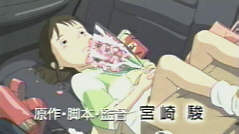
|
Chihiro, holding a bouquet on her chest, lies on her back in the back seat of her family's minivan, looking bored. As the van passes through a rural area, Chihiro watches the scenery through the van's window... | |
Gensaku, Kyakuhon, Kantoku - Hayao MIYAZAKI
Original Story, Script, Director
Seisaku Soushiki - Yasuyoshi TOKUMA
Executive Producer
Ongaku - Jo HISAISHI
Music
| Suddenly, Chihiro's attention is aroused by a strange-looking statue [see Note 1] in the trees at the side of the road. After the van passes the large gate of an old temple, we see a dark corridor or tunnel, with a closed door dimly visible in the distance. |
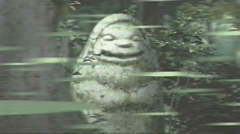
|
||
Tunnel no mukou wa fushigi no machi deshita
On the other side of the tunnel was a
town of mystery.
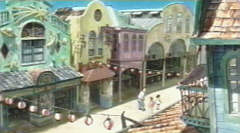
|
Chihiro, her father, and her mother stand in the middle of an empty
ghost town. Chihiro: "A town, in a place like this..." |
|
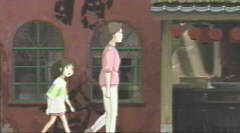
|
Chihiro and her mother walk in the town. Chihiro: "There's nobody here, is there?" |
|
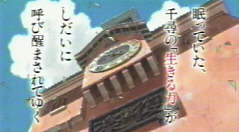
|
Crashing sounds are heard from within a large clock tower. | |
Nemutteita Chihiro no "IKIRU CHIKARA" ga shidai ni yobi
samasarete yuku.
Chihiro's once-slumbering "Power to
Live" is gradually summoned awake.
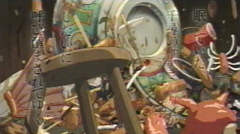
|
Inside a restaurant, a stool is smashed by a large falling pot. Chihiro looks at her hands in surprise - she can see through them. |
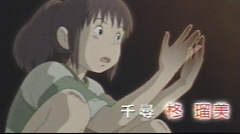
|
Chihiro - Rumi HIIRAGI
[Voice actress]
| On the balcony of a riverboat(?), invisible ghosts wearing paper masks [see Note 2] walk towards the viewer, casting shadows on the wall. Through the windows, we can see that ghosts are moving around inside. |
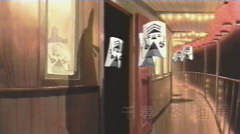
|
|
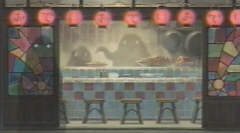
|
Behind the kitchen counter of a restaurant, ghosts are seen cooking and serving. | |
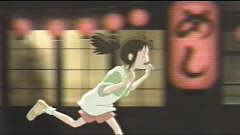
|
Chihiro runs at full speed. Chihiro: "It's a dream! It has to be a dream!" |
|
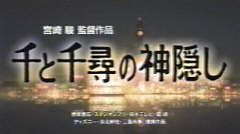
Sen to Chihiro no Kamikakushi
[The narrator also reads the title.]

|
At the end of the long, narrow corridor or tunnel (seen earlier), we can now see that the words Tachi-iri Kinshi (Do Not Enter) are painted in large characters on the closed door. | |
|
Chihiro: "Father, let's go back! Let's go
back, Father!" Chihiro touches her father's back with her hands. As her father turns around, we see that his face has become that of a pig. Chihiro's shocked face and body reactions are shown in close-up. |
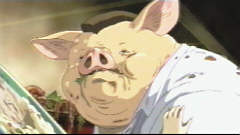
|
Shichigatsu Touhou yougakei road show
(To be released in) July, at theaters of the
Touhou Western chain
Note 1: The stone statue resembles a Douso-jin, a roadside statue of a deity from the Shinto belief that has the function of protecting travelers and ensuring their safe journey. Some also think it resembles a statue with a similar function, but deriving from Buddhist belief, called Jizou-butsu - although most Japanese people call such statues Jizou-sama with a warm feeling. Small Jizou-sama were sometimes placed in memory of children who had died, and it is common to see shawls or cloaks wrapped around the statues. The two kinds of statue - Douso-jin and Jizou-sama - are often confused, since Japanese people tend to mix Shinto belief and Buddhist belief; in fact, the custom of erecting Jizou-sama statues is thought to have come from the earlier custom of placing Douso-jin. These statues are very common objects all over Japan (even now), and had an important role in everyday spiritual life for elderly Japanese common people until 1945.
The statue in the preview looks more like a Douso-jin than Jizou-sama. However, it seems to be a "Miyazaki-original" design. It seems that it belongs to the "other world," or marks the boundary of it (Douso-jin is usually put at the border of a village to mark the boundary, or at a crossroad to show people the direction).
You can see a photo of a Douso-jin, a photo of a Jizou-butsu, and read a folk tale about Jizou-sama.
Note 2: The "masks" resemble the type which the dancers of Ama wear. Ama is one of the twelve pieces of ancient Japanese dance (Bugaku), which are danced at Shinto shrines and the Imperial court. The Ama mask (made of paper) is called Zoumen.
You can see illustrations of an Ama dancer, and of Zoumen masks.
Translation by Mikiyo HATTORI and Tom WILKES (with help from Jason MARTENS, Deborah GOLDSMITH, and Ryoko TOYAMA); HTML design and video captures by Marc GREGORY, with special thanks to Sachiko HATTORI.
Disclaimer:
©2001 NTV, Nibariki, Studio Ghibli, and/or other
appropriate copyright holders.
Translated and summarized without permission for
personal entertainment purposes only. The
quotations contained in this summary are not,
by any means, accurate word for word translations, and the
translators are solely responsible for any mistranslation or
misunderstanding.